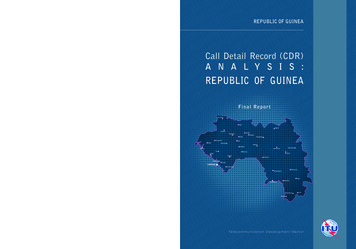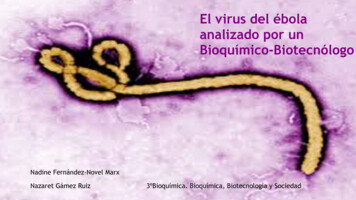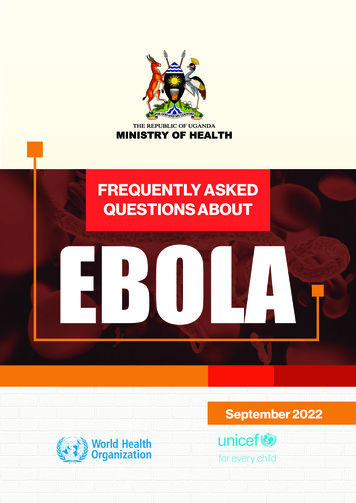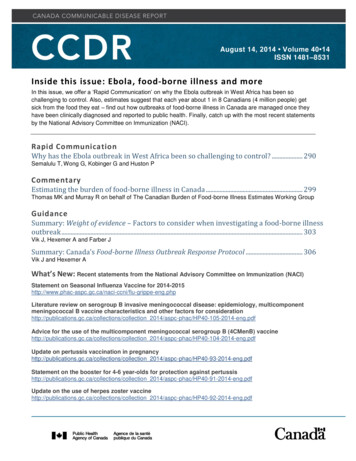
Transcription
August 14, 2014 Volume 40 14ISSN 1481–8531Inside this issue: Ebola, food-borne illness and moreIn this issue, we offer a ‘Rapid Communication’ on why the Ebola outbreak in West Africa has been sochallenging to control. Also, estimates suggest that each year about 1 in 8 Canadians (4 million people) getsick from the food they eat – find out how outbreaks of food-borne illness in Canada are managed once theyhave been clinically diagnosed and reported to public health. Finally, catch up with the most recent statementsby the National Advisory Committee on Immunization (NACI).Rapid CommunicationWhy has the Ebola outbreak in West Africa been so challenging to control? . 290Semalulu T, Wong G, Kobinger G and Huston PCommentaryEstimating the burden of food-borne illness in Canada . 299Thomas MK and Murray R on behalf of The Canadian Burden of Food-borne Illness Estimates Working GroupGuidanceSummary: Weight of evidence – Factors to consider when investigating a food-borne illnessoutbreak . 303Vik J, Hexemer A and Farber JSummary: Canada’s Food-borne Illness Outbreak Response Protocol . 306Vik J and Hexemer AWhat’s New: Recent statements from the National Advisory Committee on Immunization (NACI)Statement on Seasonal Influenza Vaccine for grippe-eng.phpLiterature review on serogroup B invasive meningococcal disease: epidemiology, multicomponentmeningococcal B vaccine characteristics and other factors for /collection 2014/aspc-phac/HP40-105-2014-eng.pdfAdvice for the use of the multicomponent meningococcal serogroup B (4CMenB) ction 2014/aspc-phac/HP40-104-2014-eng.pdfUpdate on pertussis vaccination in lection 2014/aspc-phac/HP40-93-2014-eng.pdfStatement on the booster for 4-6 year-olds for protection against lection 2014/aspc-phac/HP40-91-2014-eng.pdfUpdate on the use of herpes zoster ction 2014/aspc-phac/HP40-92-2014-eng.pdf
290 CCDR – 14 August 2014 Volume 40-14Why has the Ebola outbreak in West Africabeen so challenging to control?Semalulu T1, Wong2*2G , Kobinger G and Huston P3*1Northern Ontario School of Medicine, Thunder Bay, ONPublic Health Agency of Canada, National Microbiology Laboratory, Winnipeg, MB3Public Health Agency of Canada, Office of the Assistant Deputy Minister, Ottawa, ON*Corresponding author: gary.wong@phac-aspc.gc.ca2AbstractWest Africa is in the midst of the largest Ebola outbreak ever; there have been over 1000 deaths and many newcases are reported each day. The World Health Organization (WHO) declared it an outbreak in March 2014 andon August 6, 2014 the WHO declared the outbreak a public health emergency of international concern. Based onthe number of deaths and total number of cases reported to the WHO as of August 11, 2014, the currentoutbreak has an overall mortality rate of 55%. Outbreak control measures against Ebola virus disease areeffective. Why then, has this outbreak been so challenging to control? Ebola is transmitted through bodily fluidsand immediately attacks the immune system, then progressively attacks the major organs and the lining of bloodvessels. Sierra Leone, Guinea and Liberia are small countries that have limited resources to respond toprolonged outbreaks, especially in rural areas. This has been made more challenging by the fact that health careworkers are at risk of contracting Ebola virus disease. Treatment to date has been supportive, not curative andoutbreak control strategies have been met with distrust due to fear and misinformation. However, importantprogress is being made. The international response to Ebola is gaining momentum, communication strategieshave been developed to address the fear and mistrust, and promising treatments are under development,including a combination of three monoclonal antibodies that has been administered to two American Ebolainfected health care workers. The National Microbiology Laboratory of the Public Health Agency of Canada(PHAC) has been supporting laboratory diagnostic efforts in West Africa and PHAC has been working with theprovinces and territories and key stakeholders to ensure Canada is prepared for a potential Ebola importation.IntroductionFour West African countries are in the midst of the largest Ebola outbreak the world has seen. The World HealthOrganization (WHO) declared it an outbreak in March 2014. On August 6, 2014, the WHO, based on therecommendations of its Emergency Committee, declared the current outbreak a Public Health Emergency ofInternational Concern (PHEIC) (1). As of August 11, 2014, the WHO has reported 1848 cases and 1013 deaths inGuinea, Sierra Leone, Liberia and Nigeria (1). Based on these reported deaths and total number of cases, thisoutbreak currently has an overall mortality rate of 55%.The objective of this article is to summarize what we know about Ebola virus disease, current challenges tocontrolling the outbreak, and progress to date, including Canada’s contribution to the outbreak response.BackgroundEbola belongs to the family Filoviridae, in which most members cause severe hemorrhagic fever in humans.There are five species: Zaire ebolavirus, Sudan ebolavirus, Bundibugyo ebolavirus, Tai forest ebolavirus, andReston ebolavirus. Each species contains one virus (Table 1) (2, 3).
291 CCDR – 14 August 2014 Volume 40-14Table 1:Species of Genus Ebolavirus (3, 4)SpeciesVirusRegionFatality RateZaire ebolavirusEBOVAfrica60-90%Sudan ebolavirusSUDVAfrica40-60%Bundibugyo ebolavirusBDBVAfrica25%, based on one outbreakTai forest ebolavirusTAFVAfricaUnknown, only one known infection in Ivory CoastReston ebolavirusRESTVAsiaNot known to cause lethal infections in humans. Lethal in nonhuman primates.The current outbreak is caused by a new variant of EBOV, the species most virulent in humans (5).The natural reservoir of EBOV is unknown, but is thought to be fruit bats (6). EBOV is known to cause disease inhumans, non-human primates, and other mammals (4, 7). EBOV is thought to enter the human populationthrough exposure to the bodily fluids of an infected fruit bat or mammal, especially non-human primates. Humaninfection with EBOV has been associated with hunting and processing bushmeat (8-10).Following an incubation period of 2 to 21 days, Ebola initially presents with non-specific symptoms (e.g.headaches, fever, and muscle pain). This progresses to a rash, diarrhea and vomiting typically followed by multiorgan failure, hemorrhaging and death. Person-to-person transmission occurs through direct contact with thebodily fluids and tissues of an infected person (2). Those most at risk of infection during outbreaks are familymembers and caregivers of infected individuals, individuals in contact with dead bodies during funeralpreparations and rituals, and health care personnel through safety protocol breaches (e.g. needlestick injury) (11).Although treatment options to date have been limited, outbreak control measures are effective in arrestingtransmission when they can be executed properly. These measures include barrier and quarantine methods tolimit exposure, early identification, isolation of cases, contact tracing, communication strategies to decrease riskybehaviours, and epidemiologic surveillance (11, 12, 13).Outbreak control measures for Ebola are effective. Why then, has the West Africa outbreak been so challengingto control?The ChallengesThe Ebola virus has deadly attack mechanismsThe Ebola virus enters the host through small skin lesions and mucosal surfaces facilitated by its surfaceglycoprotein (GP). Upon cell entry, the virus replicates and, as progeny virus buds from the host cell membrane,the infected cell is destroyed (14, 15, 16). Analysis of tissues from infected human and non-human primates havedemonstrated that viral replication occurs initially in leukocytes, epithelial cells, hepatocytes, splenic, adrenalcortical, and endothelial cells (4).LeukocytesLeukocytes – macrophages, monocytes and dendritic cells – are the primary cell targets of infection (17); this hasa profound effect on the immune response. Macrophages and monocytes are part of the innate immune responseand the body’s first line of defense against infections. Cell death of monocytes and macrophages lead to amassive release of cytokines, thus attracting more macrophages to be infected (18, 19, 20). This causes apositive feedback loop between macrophages and cytokines which can lead to a dysregulated inflammatoryresponse or cytokine storm (3, 19, 20, 23).
292 CCDR – 14 August 2014 Volume 40-14The death of infected dendritic cells means they are incapable of activating the adaptive immune response.Patients with fatal Ebola virus disease show almost no viral antigen specific antibodies due to suppressed B- andT-cell immunity (21). This is caused by anti-inflammatory cytokines released by macrophages, such as interleukin10 (IL-10) (22). Thus, EBOV hyperstimulates the innate immune response and suppresses the adaptive immuneresponse.Epithelial, hepatic, splenic and adrenal cellsInfected leukocytes are thought to spread the virus systemically through the lymphatic system and blood. Thevirus then preferentially attacks epithelial, hepatic, splenic and adrenal cells (4). Infected epithelial cells lining thegut cause gastrointestinal symptoms during the early stages of infection (e.g. vomiting and diarrhea) (4). Infectedhepatocytes lead to increased liver enzyme levels and impaired liver function. This may decrease the synthesis ofcoagulation factors, contributing to coagulation abnormalities (24). Infected splenic cells can lead to necrosis andhemorrhage into the abdominal cavity. Necrosis of adrenal cortical cells affects the regulation of blood pressure,and appears to contribute to septic shock during the later stages of infection (25). The virus eventually reaches allvital organs, leading to progressive organ failure and shock (4, 20).Endothelial cellsEndothelial cells lining the blood vessels are targeted during later stages of infection. Endothelial impairment isthought to increase vascular permeability that can lead to hemorrhage, a prominent feature of infection inapproximately 40-50% of patients (5, 14).How this pathology links with clinical signs and symptoms are highlighted in Table 2.Table 2: Pathophysiology and clinical signs and symptoms of Ebola virus infectionEarly symptomsFirst weekClinical signs and symptomsPathophysiologyAbrupt onset of fever, chills, malaise, myalgiaSevere sore throatInfected monocytes and macrophagesrelease cytokinesSystemic: Prostration, lethargyCytokines contribute to systemic symptomsGastrointestinal: Anorexia, nausea,vomiting, abdominal pain, diarrhea (andprogressively bloody diarrhea andhematemesis)Viral replication in epithelial and endothelialcells lead to gastrointestinal symptoms andbleedingCardiac: Chest pain dyspnea, shortness ofbreath, cough, nasal dischargeViral replication and necrosis in cardiactissuesSplenic: Fever, abdominal pain, hemorrhage,if rupture into peritoneal cavityViral replication and necrosisHepatic: Elevated liver enzymes andcoagulation abnormalitiesLiver cells are infected leading to cell deathand affecting clotting factor productionVascular: Conjunctival injection, posturalhypotension, edemaEndothelial cells are taken over andcytokines released, leading to increasedvascular permeabilityNeurologic: Headache, confusion,encephalitis, seizure, comaViral replication in brain tissue and vasculardysfunctionSkin: Maculopapular rash with varyingdegrees of erythema and desquamationEndothelial leakage
293 CCDR – 14 August 2014 Volume 40-14ComplicationsClinical signs and symptomsPathophysiologyHemorrhageInfected hepatic cells result in elevated liverenzymes and coagulation abnormalitiesPetechiae, ecchymoses, uncontrolledbleeding from venipuncture sites, epistaxis,visceral hemorrhagic effusions and othermucosal hemorrhagesShock and hypotensionSevere metabolic disturbancesDisseminated intravascular coagulation andhypovolemic shockLaboratoryfindingsDamaged endothelial cells lead to increasedvascular permeabilityDirect viral damage of tissues and organsmay lead to organ failure and shock.Infected adrenal cells fail to regulate bloodpressure, resulting in hypotension and septicshock.Diffuse coagulopathyEarly leucopenia, lymphopenia andsubsequent neutrophilia, thrombocytopenia,prolonged prothrombin and partialthromboplastin timesInfected dendritic cells impair immuneresponseHigh serum aminotransferase levelsWidespread viral replication and cell death inspleen, kidney, liver, gonads, etc.Hyperproteinemia and proteinuriaUncontrolled upregulation of cytokines andchemokines (cytokine storm)Elimination of the reservoir is not feasibleThe prevalence and extent of the EBOV reservoir amongst wild animals is unknown, so sporadic cases oftransmission from animals to humans cannot be prevented.Treatment is supportive, not curativeThere are currently no approved therapeutic treatments for Ebola. Until recently, treatment focused onrehydration, electrolyte management, antibiotics and antivirals to treat secondary infections and medications tocontrol pain, fever and gastrointestinal distress (2).The outbreak has reached urban areasHistorically, Ebola virus disease has been responsible for smaller outbreaks in the remote forests of Sub-SaharanAfrica that have typically involved animal to human transmission and sporadic human to human transmission. Thisoutbreak marks the first time EBOV has appeared in a capital city and has been imported by an infected personinto Africa’s most populous country, Nigeria. The unprecedented size and location of the outbreak, combined withthe fact that the virus is now circulating in densely populated urban centers, sets up the conditions for sustainedhuman-to-human transmission, making the outbreak even more challenging to control (1).Affected countries have challenges in health care infrastructureSierra Leone, Guinea and Liberia are small countries that have limited resources to respond to prolongedoutbreaks, especially in rural areas. This is the first time that West Africa has had to deal with an EBOV outbreak,therefore most primary health workers did not have any prior experience dealing with this virus. Limitedsurveillance and reporting systems may have delayed outbreak identification and the subsequent globalresponse. The WHO has identified these issues as gaps in the outbreak response (1, 26).Health care workers are at risk of infectionThe WHO has reported health-facility transmission as a central issue during the current outbreak (1). Health careworkers are at risk of contracting EBOV while caring for infected patients through accidental exposure to infectedbodily fluids. To date, more than 170 health care workers have been infected and at least 81 have died (27).
294 CCDR – 14 August 2014 Volume 40-14These deaths have discouraged some health care workers and international organizations from participating intreatment and control efforts (1).Outbreak control strategies have been met with distrustPersistent community resistance has been identified as a major challenge in the health sector response to theoutbreak (1). Effective prevention and control strategies have been undermined by fear, mistrust andmisinformation within affected communities, leading some to believe that medical staff have brought the virus tothe country. This has resulted in people refusing to cooperate with medical personnel, helping patients escapeisolation wards, and exhibiting hostile behaviour (1, 26, 28). Traditional burial practices also pose a major risk toclose relatives, since they typically involve the cleaning and rubbing of dead bodies that may have a high load ofEbola virus. The recommendation that these burial practices be performed by outbreak response team membershas been perceived to conflict with beliefs and cultural practices (26).Progress to dateThe international response is building momentumInternational aid and resources have been increasingly directed to West Africa to control the EBOV outbreak. TheWHO has coordinated efforts to scale up the human and financial resources necessary to effectively conductinfection prevention and control activities and to implement infrastructure needed to manage future outbreaks,such as strengthening the surveillance and laboratory capacities. Numerous non-governmental organizations,including Médecins Sans Frontières, Save the Children, and religious organizations have been working on theground to help stop the spread of this disease (1).Based on the deliberations of an Emergency Committee, the WHO Director General has made a number ofrecommendations, including: affected states should declare the outbreak a national emergency and establish anemergency operation centre to coordinate support and response efforts; exit screening be conducted at allinternational airports, seaports and major land crossings to identify individuals with unexplained febrile illness;appropriate contact management; and all states should enhance their capacity to detect, investigate and manageEbola cases through improved surveillance, laboratory diagnostic support and rapid response (29).Canada has joined other nations, organizations, and the WHO by providing financial and technical support. As ofAugust 8, 2014, Canada has contributed over 5 million towards humanitarian, infection control and securityinterventions in West Africa (30). As a member of the WHO Global Outbreak Alert and Response Network(GOARN), Canada provides technical and human resources towards the identification and response to significantinternational outbreaks (31).The National Microbiology Laboratory (NML) of the Public Health Agency of Canada (PHAC) has worked closelywith the WHO to provide rapid diagnostic support in a mobile laboratory in Sierra Leone (32).Within Canada, PHAC is taking the lead on national preparedness for Ebola cases, working closely with theprovinces and territories and all affected stakeholders. Case definitions, infection control guidelines, public healthmanagement of cases and contacts associated with Ebola virus disease, environmental decontamination,biosafety guidelines and more are currently being updated. The Agency is also facilitating the development ofspecific clinical care guidelines with the Association of Medical Microbiology and Infectious Disease Canada, theCanadian Critical Care Society, and the Canadian Association of Emergency Physicians.
295 CCDR – 14 August 2014 Volume 40-14Communication strategies are being implemented to addressfears and misconceptionsAn assessment of the current outbreak led by Dr. Luis Sambo, the WHO Regional Director for Africa, hasrecommended that affected governments scale up national resources to promote behavioural change whilerespecting cultural practices (1). Local collaborations (e.g. training community members to identify contacts, andworking with local leaders to effectively disseminate the correct information on EBOV) are being used to dispelmisconceptions and strengthen control strategies (26). Collaborations with religious, community and tribal leadersare being used to disseminate information (26, 28). These messages are also being spread by television andradio (33).Investigational therapies are under developmentSeveral experimental treatments are currently under development (2, 34). Two infected Americans received anexperimental drug, which contains three monoclonal human-mouse chimeric antibodies manufactured in the plantNicotiana benthamiana (35). These antibodies demonstrated 100% protection against EBOV in infectedcynomolgus macaques(36).Another investigational treatment uses small interfering RNAs specific to certain EBOV genes to inhibit virusreplication. A study demonstrated 66% and 100% protection from EBOV in macaques after four and seven postexposure treatments, respectively (37).Several experimental vaccines have also shown promise against EBOV in nonhuman primates, including anadenovirus-based and a vesicular stomatitis virus (VSV)-based vaccine. For example, the VSV-based vaccinehas demonstrated high protective efficacy against EBOV disease, with an absence of noticeable adverse eventsin non-human primates (38-40). Discussions are ongoing about fast tracking both the adenovirus and the VSVbased Ebola vaccines for Phase 1 clinical trials.The use of experimental treatments on two Americans infected with EBOV has led to a WHO-hosted discussionon the ethical considerations of including such treatments in the response efforts (1, 41).ConclusionThere are a number of factors that make the Ebola virus outbreak in West Africa a challenge to control. TheEBOV has efficient ways to paralyze host defence mechanisms and attack vital organs. It resides in a poorlyunderstood wildlife reservoir and has emerged in countries that have challenges in both health care capacity andrisk communication. All these factors have occurred in the context of increasing global travel.Canada has been an integral part of the global response through sending money, providing laboratory support,developing a vaccine and post exposure treatment, and collaborating internationally. The Public Health Agency ofCanada will continue to work with its partners and coordinate the national response to enable the optimaldetection, investigation, management and reporting of any potential cases of EBOV within Canada.The WHO has identified the Ebola outbreak as a public health emergency of international concern. This willcontinue to require national and international collaboration and the ongoing vigilance of front line health care andpublic health professionals to end the outbreak in West Africa and prevent its global spread.AcknowledgementsDr. Huston is the Scientific Editor of the Canada Communicable Disease Report and recused herself from theeditorial decisions involved in this manuscript. Many thanks to Dr. Tom Wong for taking on the Editor role for thisRapid Communication. Thank you to Mike Drebot and Tim Booth for their support in developing this manuscriptand the reviewers who offered timely and useful feedback while participating in response efforts.
296 CCDR – 14 August 2014 Volume 40-14References(1) World Health Organization. Global alert and response: Ebola virus disease (EVD). World HealthOrganization cited 2014]. n/(2) World Health Organization. Ebola virus disease: background and summary. World HealthOrganization cited July 2014]. http://www.who.int/csr/don/2014 04 ebola/en/(3) Wong G, Kobinger GP, Qiu X. Characterization of host immune responses in Ebola virus infections.Expert Rev Clin Immunol 2014 Jun;10(6):781-90.(4) Feldmann H, Geisbert TW. Ebola haemorrhagic fever. Lancet. 2011 Mar 5;377(9768):849-62.(5) Baize S, Pannetier D, Oestereich L, Rieger T, Koivogui L, Magassouba N, Soropogui B, Sow MS, KeitaS, De Clerck H, Tiffany A, Dominguez G, Loua M, Traore A, Kolie M, Malano ER, Heleze E, Bocquin A,Mely S, Raoul H, Caro V, Cadar D, Gabriel M, Pahlmann M, Tappe D, Schmidt-Chanasit J, ImpoumaB, Diallo AK, Formenty P, Van Herp M, Gunther S. Emergence of Zaire Ebola virus disease in Guinea- preliminary report. N Engl J Med2014 Apr 16.(6) Leroy EM, Kumulungui B, Pourrut X, Rouquet P, Hassanin A, Yaba P, Delicat A, Paweska JT,Gonzalez JP, Swanepoel R. Fruit bats as reservoirs of Ebola virus. Nature . 2005 Dec1;438(7068):575-6.(7) Weingartl HM, Nfon C, Kobinger G. Review of Ebola virus infections in domestic animals. Dev Biol(Basel) . 2013;135:211-8.(8) Leroy EM, Rouquet P, Formenty P, Souquiere S, Kilbourne A, Froment JM, Bermejo M, Smit S,Karesh W, Swanepoel R, Zaki SR, Rollin PE. Multiple Ebola virus transmission events and rapiddecline of central African wildlife. Science. 2004 Jan 16;303(5656):387-90.(9) Nkoghe D, Kone ML, Yada A, Leroy E. A limited outbreak of Ebola haemorrhagic fever in Etoumbi,Republic of Congo, 2005. Trans R Soc Trop Med Hyg . 2011 Aug;105(8):466-72.(10) Georges-Courbot MC, Sanchez A, Lu CY, Baize S, Leroy E, Lansout-Soukate J, Tevi-Benissan C,Georges AJ, Trappier SG, Zaki SR, Swanepoel R, Leman PA, Rollin PE, Peters CJ, Nichol ST, KsiazekTG. Isolation and phylogenetic characterization of Ebola viruses causing different outbreaks inGabon. Emerg Infect Dis. 1997 Jan-Mar;3(1):59-62.(11) MacNeil A, Rollin PE. Ebola and Marburg hemorrhagic fevers: Neglected tropical diseases? PLoSNegl Trop Dis . 2012 Jun;6(6):e1546.(12) Raabe VN, Borcherta M. Infection control during filoviral hemorrhagic fever outbreaks. J GlobInfect Dis. 2012;4(1):69-74.(13) World Health Organization. Case definition recommendations for Ebola or Marburg Virus Diseases.Geneva, Switzerland: World Health Organization April 2014 cited August 2014]; ebola/ebola-case-definition-contact-en.pdf?ua 1(14) Hoenen T, Groseth A, Falzarano D, Feldmann H. Ebola virus: Unravelling pathogenesis to combat adeadly disease. Trends Mol Med . 2006 May;12(5):206-15.(15) Sullivan N, Yang ZY, Nabel GJ. Ebola virus pathogenesis: Implications for vaccines and therapies. JVirol. 2003 Sep;77(18):9733-7.
297 CCDR – 14 August 2014 Volume 40-14(16) Beniac DR, Melito PL, Devarennes SL, Hiebert SL, Rabb MJ, Lamboo LL, Jones SM, Booth TF. Theorganisation of Ebola virus reveals a capacity for extensive, modular polyploidy. PLoS One .2012;7(1):e29608.(17) Geisbert TW, Young HA, Jahrling PB, Davis KJ, Larsen T, Kagan E, Hensley LE. Pathogenesis of Ebolahemorrhagic fever in primate models: Evidence that hemorrhage is not a direct effect of virusinduced cytolysis of endothelial cells. Am J Pathol . 2003 Dec;163(6):2371-82.(18) Bray M, Geisbert TW. Ebola virus: The role of macrophages and dendritic cells in the pathogenesisof Ebola hemorrhagic fever. Int J Biochem Cell Biol. 2005 Aug;37(8):1560-6.(19) Feldmann H, Bugany H, Mahner F, Klenk HD, Drenckhahn D, Schnittler HJ. Filovirus-inducedendothelial leakage triggered by infected monocytes/macrophages. J Virol . 1996 Apr;70(4):220814.(20) Zampieri CA, Sullivan NJ, Nabel GJ. Immunopathology of highly virulent pathogens: Insights fromEbola virus. Nat Immunol . 2007 Nov;8(11):1159-64.(21) Wong G, Richardson JS, Pillet S, Patel A, Qiu X, Alimonti J, Hogan J, Zhang Y, Takada A, Feldmann H,Kobinger GP. Immune parameters correlate with protection against Ebola virus infection in rodentsand nonhuman primates. Sci Transl Med . 2012 Oct 31;4(158):158ra146.(22) Said EA, Dupuy FP, Trautmann L, Zhang Y, Shi Y, El-Far M, Hill BJ, Noto A, Ancuta P, Peretz Y,Fonseca SG, Van Grevenynghe J, Boulassel MR, Bruneau J, Shoukry NH, Routy JP, Douek DC,Haddad EK, Sekaly RP. Programmed death-1-induced interleukin-10 production by monocytesimpairs CD4 T cell activation during HIV infection. Nat Med. 2010 Apr;16(4):452-9.(23) Wauquier N, Becquart P, Padilla C, Baize S, Leroy EM. Human fatal Zaire Ebola virus infection isassociated with an aberrant innate immunity and with massive lymphocyte apoptosis. PLoS NeglTrop Dis . 2010 Oct 5;4(10):10.1371/journal.pntd.0000837.(24) Geisbert TW, Jahrling PB, Hanes MA, Zack PM. Association of Ebola-related Reston virus particlesand antigen with tissue lesions of monkeys imported to the United States. J Comp Pathol . 1992Feb;106(2):137-52.(25) Ryabchikova EI, Kolesnikova LV, Luchko SV. An analysis of features of pathogenesis in two animalmodels of Ebola virus infection. J Infect Dis . 1999 Feb;179 Suppl 1:S199-202.(26) Andrew Green. Ebola emergency meeting establishes new control centre. Lancet. 2014;384:118.(27) World Health Organization. Barriers to rapid containment of the Ebola outbreak. Geneva,Switzerland: World Health Organization cited August w-august-2014/en/(28) World Health Organization. Busting the myths about Ebola is crucial to stop the transmission of thedisease in Guinea. Geneva, Switzerland: World Health Organization cited July /en/(29) World Health Organization. WHO Statement on the Meeting of the International HealthRegulations Emergency Committee Regarding the 2014 Ebola Outbreak in West Africa Geneva,Switzerland: World Health Organization August 8, 2014 cited August 014/ebola-20140808/en/
298 CCDR – 14 August 2014 Volume 40-14(30) Government of Canada. Canada’s response to the Ebola outbreak in the West Africa regionGovernment of Canada August 8, 2014 cited August s-communiques/2014/08/08b bg.aspx?lang eng(31) World Health Organization. Global alert and response: Global Outbreak Alert and ResponseNetwork Geneva, Switzerland: World Health Organization cited August 2) Public Health Agency of Canada. Statement from Dr. Gregory Taylor, the Deputy Chief PublicHealth Officer, on the Ebola Outbreak in Africa . Public Health Agency of Canada July 2014 citedJuly 2014]. 140730-eng.php(33) World Health Organization. Involving everyone: social mobilization is key in an Ebola outbreakresponse [Internet]. World Health Organization May 2014 cited July lisation/en/(34) Leroy EM, Gonzalez JP, Baize S. Ebola and Marburg haemorrhagic fever viruses: Major scientificadvances, but a relatively minor public health threat for Africa. Clin Microbiol Infect 2011Jul;17(7):964
290 CCDR - 14 August 2014 Volume 40-14 Why has the Ebola outbreak in West Africa been so challenging to control? Semalulu T 1 Wong G 2*, Kobinger G2 and Huston P 3* 1 Northern Ontario School of Medicine, Thunder Bay, ON 2 Public Health Agency of Canada, National Microbiology Laboratory, Winnipeg, MB 3 Public Health Agency of Canada, Office of the Assistant Deputy Minister, Ottawa, ON
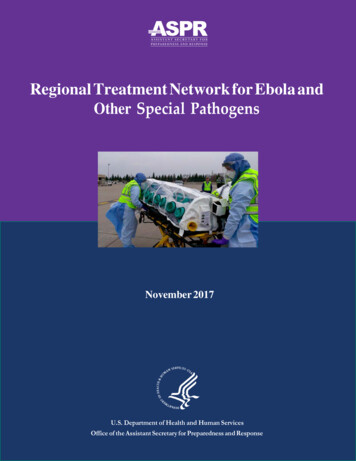
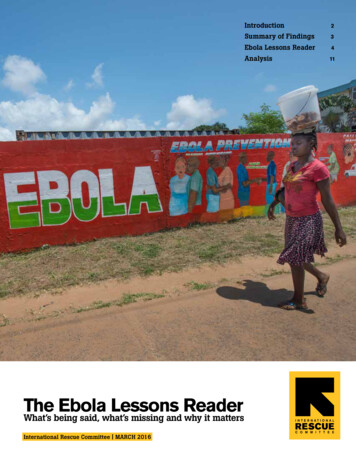

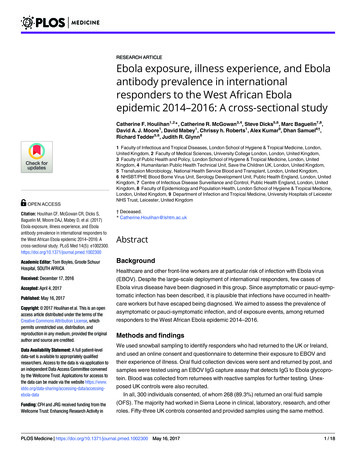



![f][triazin-4-amino] Adenine C-Nucleoside for the Treatment of Ebola and .](/img/14/ad1031184.jpg)
